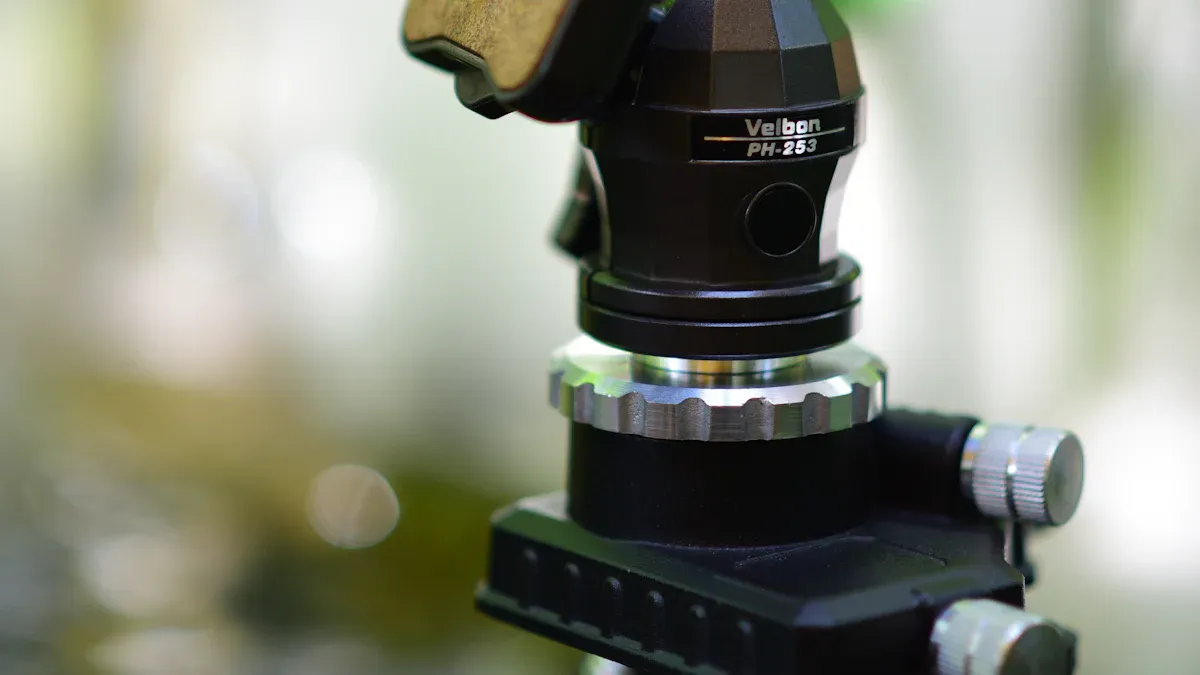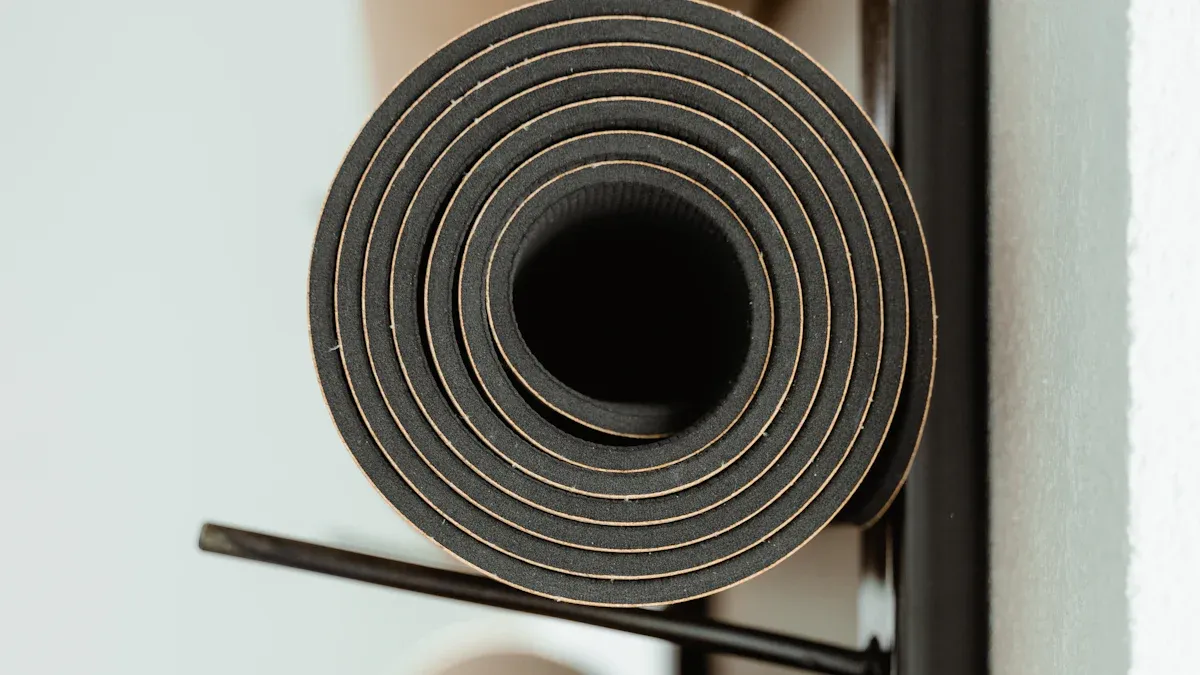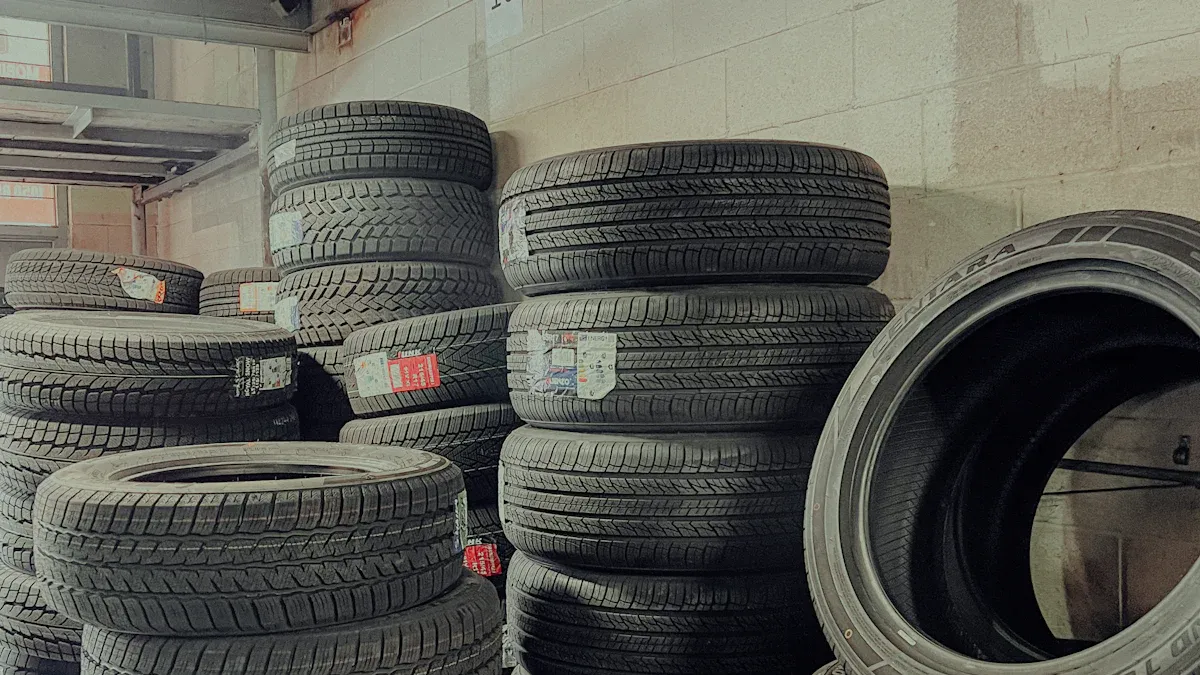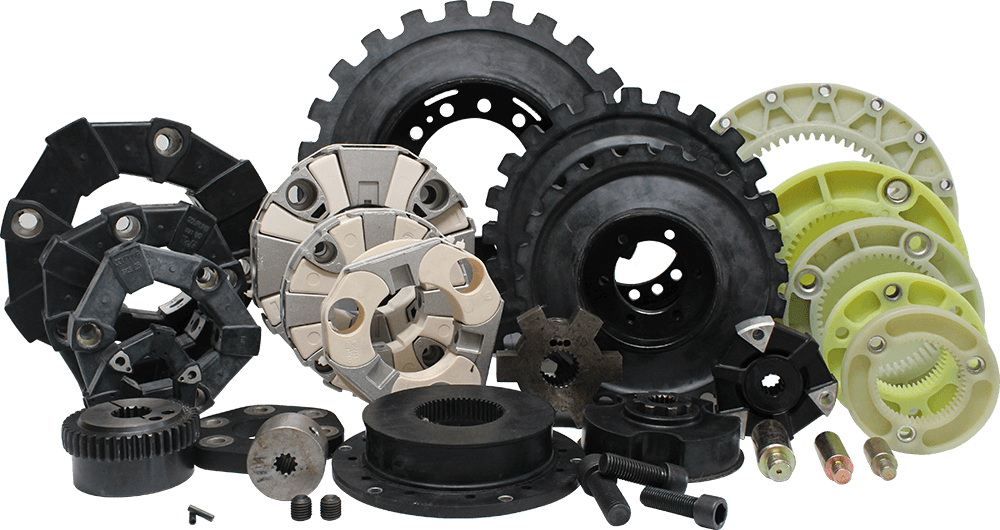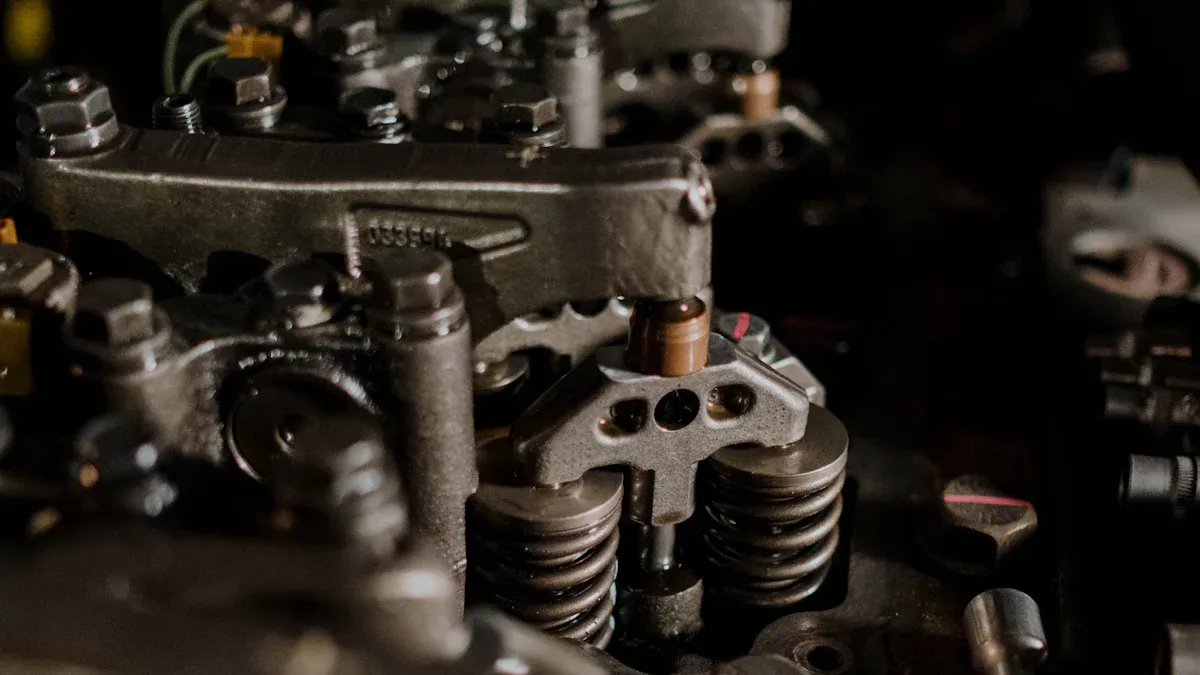
Choosing the right rubber motor mounts helps your car run well. You need mounts that fit your engine and car type. This helps lower vibration and makes the ride smoother. Studies show good mounts with the right shape and material cut down vibration. They can make the ride feel almost 16% better. Mounts that fit well also protect your engine from stress and heat. This helps your engine last longer. If you pick the wrong mounts, you get more vibration and rough rides. Your engine may not last as long. Use this guide to help you make the best choice.
Key Takeaways
Pick motor mounts that match your engine size. Make sure they fit your vehicle type. This helps lower vibration and keeps your engine safe.
Choose rubber that works well in your engine’s area. Use silicone if it gets hot. Use neoprene if there is oil.
Think about the mount type you need. Rubber mounts give comfort. Polyurethane mounts last a long time. Hydraulic mounts stop vibration best.
Always look at load and vibration ratings. Make sure the mount can hold your engine’s weight. Make sure it can handle shaking.
Ask an expert for help. Follow the right steps to install the mount. This stops the mount from breaking early. It keeps your engine safe.
Engine Requirements
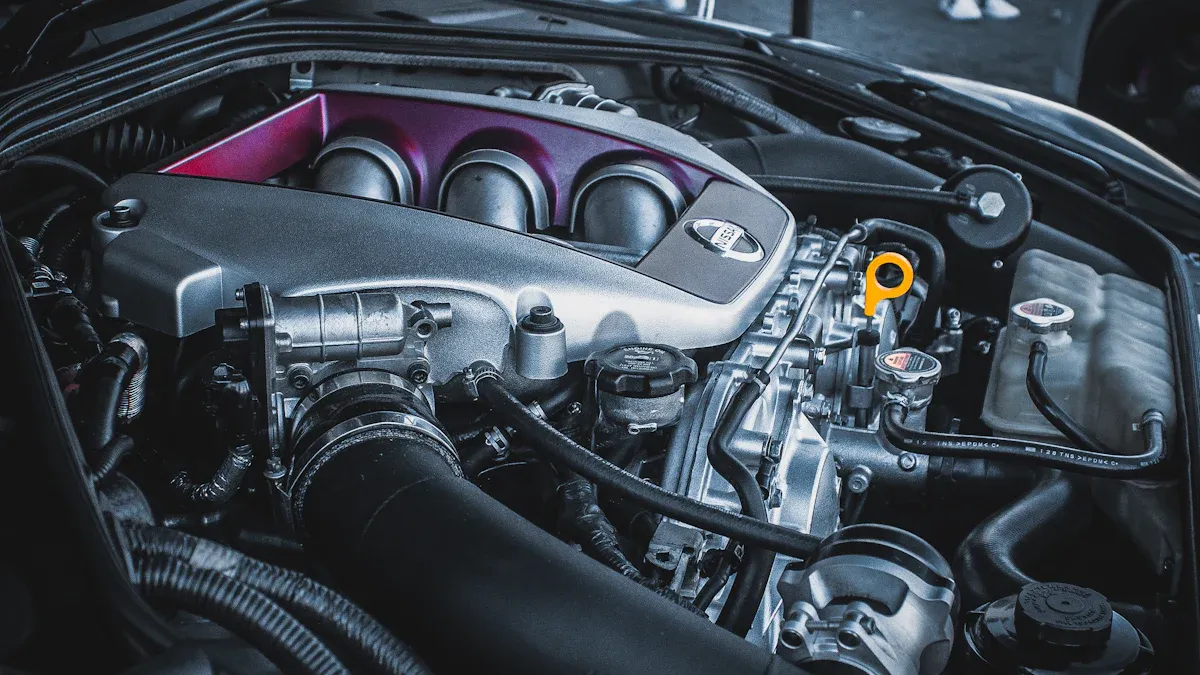
Engine Size
You should think about your engine size when picking a rubber motor mount. Small engines usually do fine with rubber mounts. These mounts are simple and help stop vibration. Many small cars use them to keep rides smooth and quiet. Big engines, like in trucks or SUVs, need stronger mounts. These engines make more vibration and are heavier. Hydraulic mounts or custom rubber mounts work better for them. The size of your engine decides what kind of mount you need. If the mount is too weak, you will feel more shaking and noise. Always look at your engine’s details before choosing a mount.
Rubber mounts: Good for small and medium engines.
Hydraulic mounts: Used for big engines that need more vibration control.
Mounting Points
Mounting points are where the engine connects to the car’s frame. Each engine has its own setup. Some engines use one-piece mounts. Others need two-piece or base plate mounts. The mount’s shape and size must fit your engine’s mounting points. If it does not fit, it will not work right. Custom mounts help if your engine or car is special. Always match the mount to your engine’s mounting points. This gives a tight fit and better vibration control.
Tip: Look in your car’s manual or ask a mechanic to find your engine’s mounting point layout.
Vehicle Type
The kind of car you drive changes what mount you need. Different cars need different mounts for best comfort and performance. Here is a quick guide:
Mount Type | Best For | Reason for Use |
|---|---|---|
Rubber Mounts | Economy cars, daily drivers | Cheap, basic vibration control |
Polyurethane Mounts | Sports cars, performance cars | Stiffer, better handling, more vibration transfer |
Hydraulic Mounts | Luxury vehicles, SUVs | Better damping, smoother ride |
Electronic Mounts | High-end luxury vehicles | Advanced vibration management |
If you drive a daily car like a Toyota Corolla, rubber mounts are a good choice. Sports cars like a Subaru WRX may use stiffer mounts for better handling. Luxury cars often use hydraulic or electronic mounts for a smoother ride. Always pick a mount that matches your engine and car type for the best results.
Rubber Motor Mounts: Key Factors
Load & Vibration
When picking rubber motor mounts, think about weight and vibration. If the mount is too weak, it can break fast. You should figure out your engine’s weight. Make sure the weight spreads across all mounting points. Measure how much your engine shakes and how fast it runs. Check how much the mount squishes under weight. Look at where your engine sits. If it faces oil, heat, or chemicals, pick tough rubber.
Figure out engine weight and spread it out.
Measure vibration and engine speed.
Check how much the mount squishes.
Pick tough rubber for harsh places.
Tip: Always check the load rating and how much the mount bends. These numbers show how much weight the mount holds and how much it bends while working.
Rubber motor mounts keep your engine steady. They cut down shaking and noise. This makes your car smoother and keeps the engine safe.
Rubber Hardness
Rubber hardness changes how well mounts block vibration. The Shore hardness scale shows how hard or soft rubber is. Softer rubber absorbs more shaking. This makes rides quieter and smoother. Harder rubber holds more weight and lasts longer. But it does not block vibration as well.
Pick the right hardness for your engine and driving style. If you want less shaking, pick softer rubber. If you need more strength, pick harder rubber. The table below shows how hardness changes vibration and noise:
Parameter | Value/Range | Effect on Vibration and Noise Reduction |
|---|---|---|
Radial stiffness (N/m) | 100,000 – 200,000 | Best vibration damping |
Torsional stiffness (N·m/rad) | ~30 | Best vibration damping |
Vibration reduction | Up to 99% compared to rigid gear | Much less noise and vibration |
Natural frequencies | Go up with hardness but stay below rigid gear | Keeps vibration damping strong |
Rubber motor mounts with the right hardness can cut engine shaking by up to 99%. The chart below shows that harder rubber raises natural frequencies. But it still blocks vibration better than stiff gears.
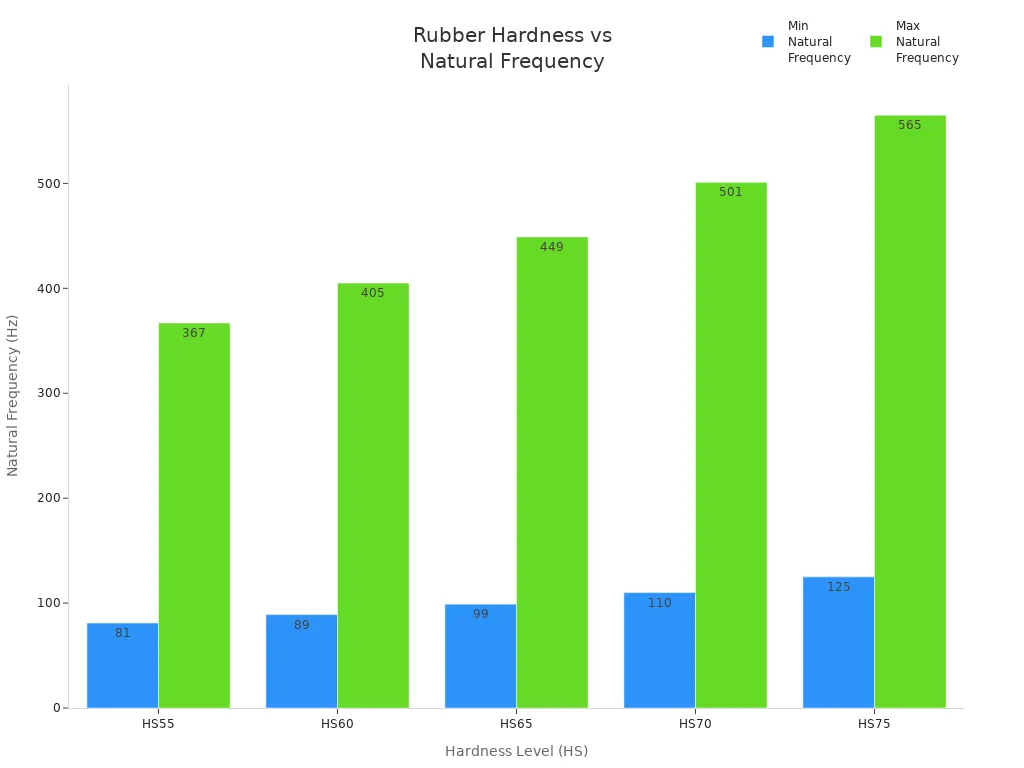
Material Types
Rubber types change how well motor mounts work. Pick the right type for your engine’s place. Here is a quick guide:
Material | Advantages | Disadvantages |
|---|---|---|
Natural Rubber | Strong, stretchy, blocks vibration, eco-friendly | Breaks down with heat, UV, chemicals; can cause allergies |
Neoprene | Handles oil and heat, strong, flexible, resists sunlight | Gets stiff in cold; can be hurt by gasoline; works from -40°C to +125°C |
EPDM | Great with heat, ozone, and weather; good outside | Not as stretchy as natural rubber; very stiff in cold; does not block oil well |
Silicone | Handles high heat, stays flexible, safe for food | Not as strong as other rubbers; wears out faster under heavy loads |
If your engine faces lots of heat or oil, silicone and Viton work best. EPDM is good for outdoor parts. Neoprene handles oil and grease. Natural rubber works for basic mounts but does not last in tough places.
Rubber Material | Heat Resistance | Oil Resistance | Environmental Resistance (Oxidation, Weather, Ozone) | Typical Automotive Uses |
|---|---|---|---|---|
EPDM | Great with heat and oxidation | Not great with oil | Great with weather and oxidation | Door seals, weatherstripping, hoses outdoors |
Nitrile Rubber (NBR) | Good with heat | Handles oils and fuels | Moderate | Gaskets, seals, fuel system parts |
Silicone Rubber | Handles very hot and cold (-60°C to 200°C) | Okay with oil | Great with sunlight, ozone, oxidation | Turbocharger hoses, high-heat places |
Polychloroprene (Neoprene) | Good with heat | Good with oil | Good with fire and weather | CV boots, weatherstripping, belts |
Viton | Handles very high heat (up to 204°C or more) | Handles chemicals and oil | Great with chemicals and weather | Fuel system gaskets, tough chemical places |
Natural Rubber | Good with heat | Bad with oil | Bad with ozone and fire | Engine mounts (not much oil) |
Note: For tough engine places, pick rubber motor mounts made from silicone, Viton, or EPDM. These rubbers last longer and fight damage from heat, oil, and weather.
YNF Rubber has many rubber motor mounts made from strong rubber. You can find mounts that fit your engine and handle tough places.
Mount Structure
Mount structure matters for blocking vibration and noise. Most mounts use a “three-layer sandwich” design. Steel is on the outside. Rubber is in the middle. Steel holds the engine’s weight. Rubber blocks vibration.
Rubber engine mounts use special rubber to make them strong. Rubber soaks up and spreads out shaking energy. This keeps noise and shaking out of your car. Makers add coatings and strong glue to stick rubber to metal. This helps the mount last longer and work better.
Tip: Look for mounts with strong rubber-to-metal glue and a good sandwich design. These features help your engine run smoother and keep your ride quiet.
Engine Mounts: Types & Choices
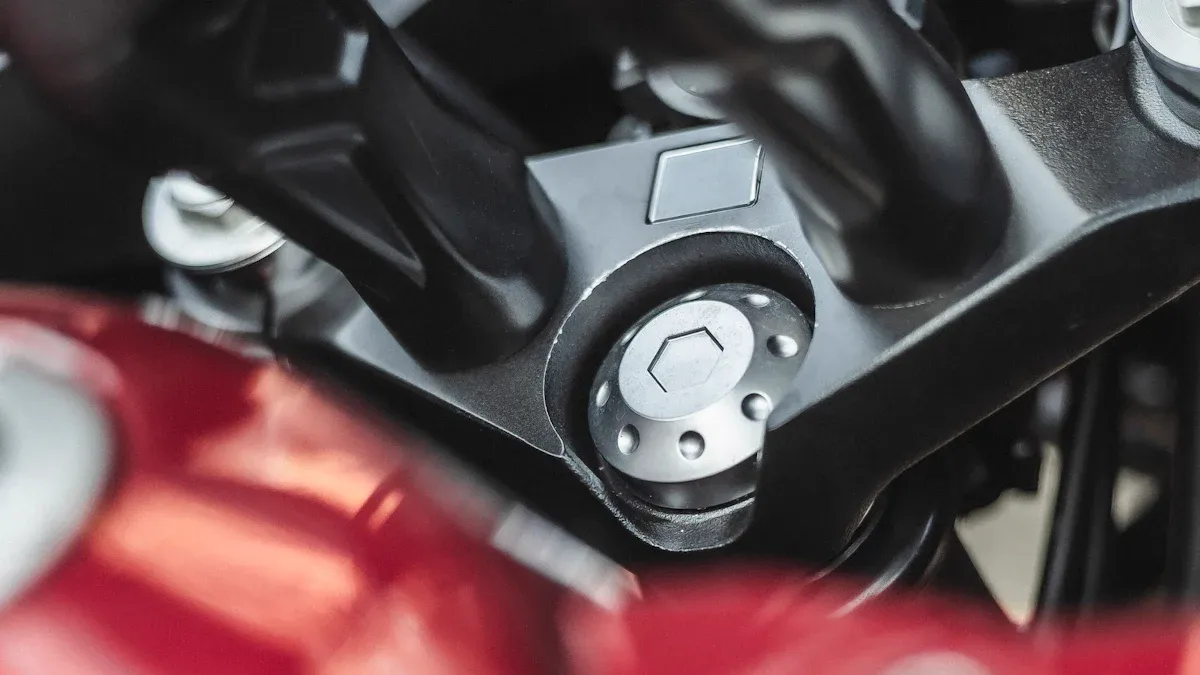
Rubber vs. Polyurethane
When you pick engine mounts, you often choose between rubber motor mounts and polyurethane engine mounts. Each one is good for different reasons.
Rubber motor mounts make your ride quiet and comfy. They soak up vibration and meet most car makers’ rules. But rubber can wear out over time. When this happens, it does not block vibration as well. Your engine may move more, and your car may not handle as well, especially if you drive hard.
Polyurethane engine mounts last longer and can handle oil, chemicals, and weather. They keep the engine in place, which helps with throttle and handling. You might hear more noise and feel more vibration, especially when the engine is idling. Polyurethane is best if you want better performance or drive in tough places.
Here is a simple comparison:
Feature | Polyurethane Engine Mounts | Rubber Motor Mounts |
|---|---|---|
Durability | Lasts longer, resists wear and chemicals | Wears out over time, less durable |
Performance | Improves handling, less engine movement | Softer, more engine movement |
Vibration Control | May increase vibration at idle | Good at first, but degrades |
Cost | Higher upfront cost, saves money long term | Lower cost, but may need more replacements |
Comfort | Less comfortable, more noise | More comfortable, less noise |
Tip: If you drive every day, rubber motor mounts are best for comfort. If you race or need strong mounts, pick polyurethane for strength and long life.
Hydraulic Mounts
Hydraulic engine mounts use liquid to soak up vibration. These mounts give the best control over shaking. Your ride feels smoother and quieter, even with a big engine. Hydraulic mounts are great for fancy cars and SUVs. They help protect your engine and make your car last longer. Rubber mounts cost less and work for most cars, but hydraulic mounts are better for blocking noise and shaking in hard driving.
Hydraulic mounts use liquid to stop vibration.
Best for strong, fancy, or heavy vehicles.
Rubber mounts are cheaper and flexible, but hydraulic mounts give more comfort and keep the car steady.
OEM vs. Aftermarket
You can get engine mounts from the car maker (OEM) or from other companies (aftermarket). OEM mounts cost more, but they fit better and cut down engine shaking. Your ride is smoother, especially when stopped. Aftermarket mounts cost less and are easy to find. Some use harder rubber, which can make your engine feel rougher at low speeds. Quality is not always the same. If you want your car to last and run smooth, OEM mounts are a safe pick. If you want to save money and do not mind more shaking, aftermarket mounts may be okay.
Aspect | OEM Motor Mounts | Aftermarket Motor Mounts |
|---|---|---|
Cost | Higher | Lower |
Fitment | Best fit, less vibration | May not fit as well |
Comfort | Smoother ride | Can cause more vibration |
Durability | Lasts longer | Quality varies |
Note: For the best quality and comfort, pick OEM engine mounts. For cheaper repairs, aftermarket mounts can save money but may not last as long.
If you need help picking engine mounts, YNF Rubber has many choices for different engines and driving styles.
Match to Engine
Specs & Dimensions
You need to make sure your rubber motor mount matches your engine’s size and shape. The right mount keeps your engine steady and stops other parts from breaking. If the mount is too soft or small, your engine can move around a lot. This can hurt things like exhaust pipes and wires. If the mount is too hard or big, it will not soak up vibration well. This can make your ride feel bumpy.
Rubber motor mounts need to be both strong and bendy. Strong mounts stop the engine from moving too much. Bendy rubber helps soak up shaking, so your ride is smoother. Always check how heavy your engine is. Heavy engines need tough mounts with thick rubber or extra metal. If your engine shakes a lot, you might need a special mount that blocks more vibration. Engines that get very hot need mounts made from heat-proof materials.
Engine weight changes how strong the mount should be.
More shaking means you need mounts that block vibration.
Hot engines need mounts that can handle heat.
The mount’s size and strength should balance shaking and steadiness.
If you do not match the specs, you can have problems. If you put the mount in wrong or line it up badly, it can break early. Using the wrong bolts or shims can make your engine shake or move. Always use the right size and kind of bolts. Keep the mounts lined up straight with the engine brackets. This helps the mounts last longer and keeps your engine safe.
Budget & Conditions
How much money you have and where your engine works are both important when picking a rubber motor mount. Mounts made from strong stuff like polyurethane cost more but last longer. For normal driving, regular rubber mounts are cheaper and usually work fine.
Where your engine runs matters as much as price. If your engine gets really hot or cold, or if it touches oil or chemicals, you need special rubber mounts. Water, sunlight, and ozone can also wear out normal rubber. Think about how heavy your engine is and how fast it runs. Some mounts, like threaded stud mounts or bearing mounts, hold heavy engines better. Others, like quick-change or floating mounts, are good for special jobs.
Picking the right mount means you need to think about your engine, the weather, and your budget. If you pick the wrong mount or material, it might break early and cost more later. For example, neoprene mounts do not last long if they get covered in oil. Even the best rubber will not work if you do not install it right.
Here is a table that shows the usual prices for good rubber motor mounts for some popular cars:
Vehicle Model & Year | Engine Size | Kit Pieces | Price (USD) |
|---|---|---|---|
2017-2020 Jeep Compass | 2.4L | 2 pcs | $79.50 |
2015-2020 Jeep Renegade | 2.4L | 2 pcs | $79.50 |
2006-2010 Honda Civic | 1.8L | 4 pcs | $62.50 |
2003-2007 Honda Accord | 2.4L | 6 pcs | $61.80 |
2007-2011 Toyota Camry | 2.4L | 4 pcs | $69.50 |
2016-2019 Ford Explorer | 3.5L | 3 pcs | $125.00 |
2016-2021 Chevy Malibu | 1.5L | 3 pcs | $109.00 |
2009-2013 Toyota Corolla Matrix | 1.8L | 4 pcs | $49.50 |
2007-2016 Nissan Altima | 2.5L | 4 pcs | $65.80 |
Individual Mount (Nissan Versa Torque Strut) | 1.8L | 1 pc | $18.90 |
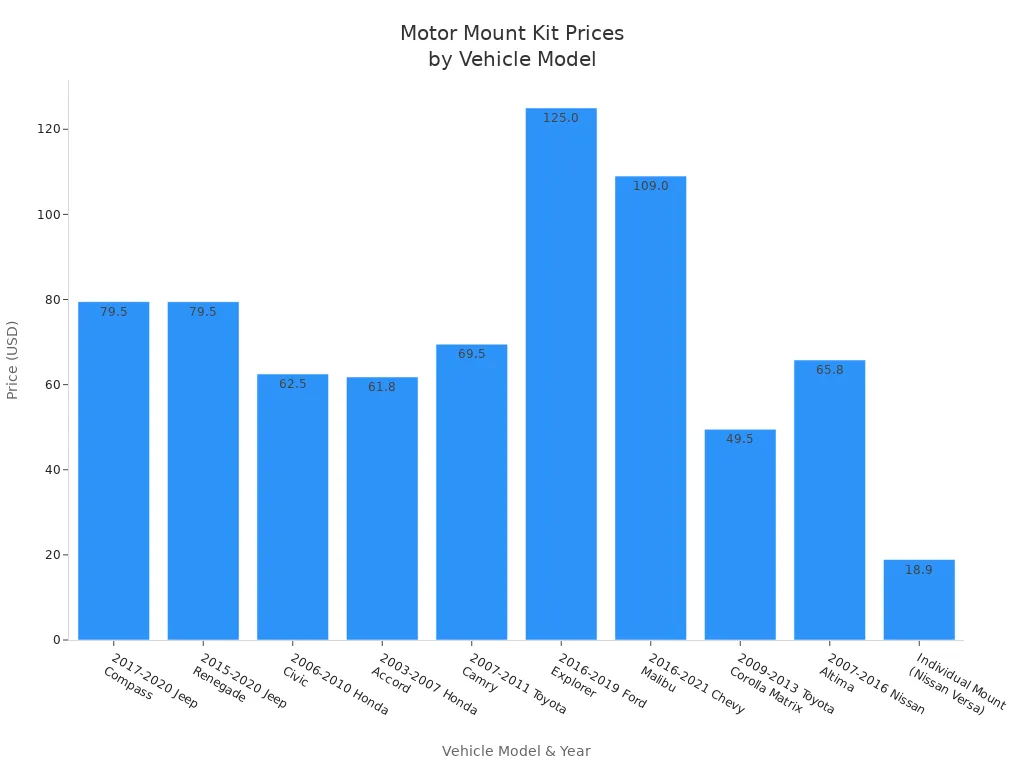
Tip: Always think about both the price and where your engine works. Spending a bit more on the right mount can save you money on fixing things later.
Professional Advice
Getting help from an expert can make picking a rubber motor mount easier. Professionals know how to balance comfort, strength, and how well it works. They look at your car, how you drive, and what you want from your mounts. If you want a quiet car, rubber mounts are good but might crack after a while. Polyurethane mounts last longer and keep the engine still, but you might feel more shaking.
A pro can tell you if you need extra things, like torque-limiting straps, to keep your engine safe. They also know how to avoid mistakes, like using the wrong bolts or not lining up the mounts. This advice helps you stop early mount failure and keeps your engine running well.
Experts help you pick the right mount for your engine’s power and how you use it.
They tell you which material is best for your driving.
Good advice helps you avoid mistakes and get the most out of your mounts.
If you want good rubber motor mounts, YNF Rubber has many choices for different cars and engines. Their mounts help you get the right fit, last longer, and make your ride more comfortable.
Mistakes to Avoid
Ignoring Ratings
You should always check the ratings before picking a motor mount. Each mount has a load rating and vibration rating. These numbers tell you how much weight the mount can hold and how well it blocks shaking. If you ignore these ratings, you risk using a mount that cannot support your engine. This can lead to more noise, extra movement, and even damage to nearby parts. Solid engine mounts may seem strong, but if they do not match your engine’s needs, they can cause harsh rides and quick wear. Always match the mount’s ratings to your engine’s weight and power.
Tip: Look for the load and vibration ratings on the product label or ask your supplier for details.
Overlooking Environment
Many people forget to think about where their engine works. Heat, oil, water, and chemicals can break down some rubber mounts fast. If you use the wrong material, your mount may crack or lose strength. This can make your engine move too much and cause leaks or broken wires. You should pick a mount made for your engine’s environment. For example, if your engine faces high heat or oil, choose a mount made from silicone or EPDM. Regular checks help you spot cracks, rust, or loose bolts early.
Heat and oil can weaken rubber.
Water and sunlight can cause cracks.
Bad mounts can lead to leaks and engine damage.
Skipping Guidance
You might think you can pick a motor mount without help, but skipping expert advice can cause big problems. When you choose the wrong mount, your engine may twist or rock. This puts stress on hoses, wires, and the exhaust. In some cars, a bad mount can even affect how the throttle or shifter works. You may not notice these problems until something breaks. Experts know how to match mounts to your engine and install them right. They check alignment, torque, and the environment. This helps prevent early failure and keeps your car safe.
Improper mount choice can cause misalignment and more vibration.
Engine and transmission damage can happen from bad alignment.
Safety risks increase if your engine is not stable.
Costly repairs often follow if you skip expert help.
If you want to avoid these mistakes, talk to a trusted supplier like YNF Rubber. They can help you choose the right mount for your engine and driving needs.
Selection Steps
Gather Data
Before you choose a rubber motor mount, you need to collect the right information. This step helps you avoid mistakes and find a mount that fits your engine and vehicle. Start by gathering these key details:
Find out what type of engine mount you need. Decide if you want a rubber, hydraulic, or active mount.
Check your engine size and type. Make sure the mount matches your engine’s needs.
Write down your vehicle’s make and model. This helps you match the mount to your car.
Think about how you drive. If you drive in rough conditions or carry heavy loads, you may need a stronger mount.
Calculate your engine’s weight. Use the engine’s mass and gravity to get the right number.
Look at how much your engine vibrates. Think about how often you want to do maintenance.
Tip: Keep all this data in one place. It makes the next steps much easier.
Shortlist Mounts
Now that you have your data, you can start making a list of possible mounts. Use your notes to compare different options. Look for mounts that fit your engine size, vehicle model, and driving style. Check the material and structure of each mount. Make sure each one can handle your engine’s weight and vibration.
Compare the load ratings and vibration control features.
Check if the mount’s material matches your engine’s environment.
Look for mounts with good reviews or trusted brands.
A table can help you see the differences:
Mount Model | Engine Size | Material | Load Rating | Vibration Control | Price |
|---|---|---|---|---|---|
Mount A | 2.0L | Rubber | 150 kg | High | $60 |
Mount B | 2.4L | Neoprene | 180 kg | Medium | $75 |
Mount C | 3.0L | Polyurethane | 200 kg | Low | $90 |
Evaluate & Choose
After you make your shortlist, it is time to pick the best mount. Look at each option and see which one matches your needs the most. Think about your budget, how long you want the mount to last, and how much comfort you want. If you are not sure, ask a professional or your supplier for advice.
Note: Choosing a trusted supplier like YNF Rubber can help you get a mount that fits well and lasts longer. Their experts can guide you through the process and answer your questions.
Take your time with this step. The right choice will keep your engine safe and your ride smooth.
You can choose the right rubber motor mount by following these steps:
Check if the mount fits your engine and vehicle.
Pick the best material for your driving needs.
Match the mount to your budget and environment.
Careful selection helps your engine run smoothly and last longer. If you want expert advice and quality mounts, consider YNF Rubber for your next purchase.
FAQ
What signs show that I need new rubber motor mounts?
You may notice more vibration, clunking sounds, or your engine moving too much. Sometimes, you see cracks or wear on the mounts. If you spot these problems, you should replace your mounts soon.
How do I know which rubber material is best for my engine?
Check your engine’s environment. If you face high heat or oil, choose silicone or EPDM. For normal use, natural rubber works well. Always match the material to your engine’s needs for the best results.
Can I install rubber motor mounts by myself?
You can install mounts if you have basic tools and follow your car’s manual. If you feel unsure, ask a mechanic for help. Safety matters most when working with engine parts.
How often should I check my motor mounts?
Check your mounts every 30,000 to 50,000 miles. Look for cracks, loose bolts, or extra movement. Regular checks help you catch problems early and keep your engine safe.
Where can I buy quality rubber motor mounts?
You can find quality mounts from trusted suppliers. YNF Rubber offers many options for different engines and vehicles. Their products help you get the right fit and long-lasting performance.


